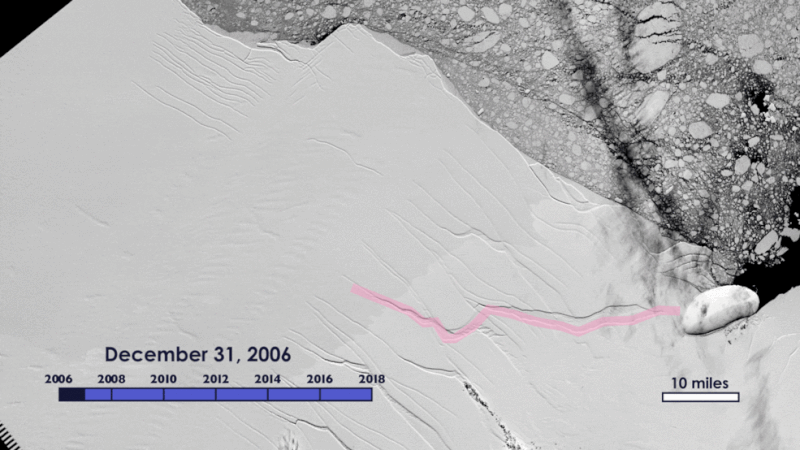
In recent days, several satellites in Earth-orbit and a British Antarctic research project all have witnessed the birth of a huge iceberg – about the size of the U.S. state of Delaware – which split off from Antarctica’s Larsen C ice shelf sometime between July 10 and July 12. Project Midas, an Antarctic research project based in the United Kingdom, was the first to report the breakage. NASA’s Aqua satellite captured images, such as the image above, and the joint NASA/NOAA Suomi-NPP satellite also confirmed it.
The new iceberg is no surprise. Scientists had been aware of and monitoring a growing crack in the Larsen C ice sheet for many years.

Larsen C is a floating platform of glacial ice on the east side of the Antarctic Peninsula. It’s the fourth largest ice shelf ringing Earth’s southernmost continent. For decades until 2014, a crack had been slowly growing into the ice shelf; then, suddently, it started to spread more rapidly northwards. The result is the new iceberg.
Now that the close to 2,240 square-mile (5,800 square kilometers) chunk of ice has broken away, the Larsen C shelf area has shrunk by approximately 10 percent. Kelly Brunt (@kbrunt on Twitter), a glaciologist with NASA’s Goddard Space Flight Center in Greenbelt, Maryland, said in a statement from NASA:
The interesting thing is what happens next, how the remaining ice shelf responds. Will the ice shelf weaken? Or possibly collapse, like its neighbors Larsen A and B? Will the glaciers behind the ice shelf accelerate and have a direct contribution to sea level rise? Or is this just a normal calving event?
Read more from NASA about the new iceberg

By the way, it was NASA, probably, that first compared the iceberg’s size to the U.S. state of Delaware; the iceberg measures 2,240 square miles, and Delaware has 1,954 square miles. Many U.S. news organizations have published that comparison also (including EarthSky), but different global news sources compared it to different parts of the globe. The New York Times ran an amusing story about them this morning, which included the comparisons and tweet below:
The London Evening Standard said the iceberg was four times the size of London, or ‘around 15 times the size of the Isle of Wight, twice the size of Luxembourg and a quarter the size of Wales.’
CNN wrote that it was ‘half the size of Qatar’ before adding that it was ‘the size of four Londons or more than seven New York Citys.’
The Associated Press went with the same description offered by the researchers: a volume about twice that of Lake Erie.
Mashable said it could fill 462 million Olympic-size swimming pools.
I'll standardize it for the press: The iceberg that broke from Antarctica today was roughly the size of 29 million cats.
— Bess Kalb (@bessbell) July 12, 2017
Bottom line: An iceberg – about the size of the U.S. state of Delaware – split off from Antarctica’s Larsen C ice shelf sometime between July 10 and 12.











